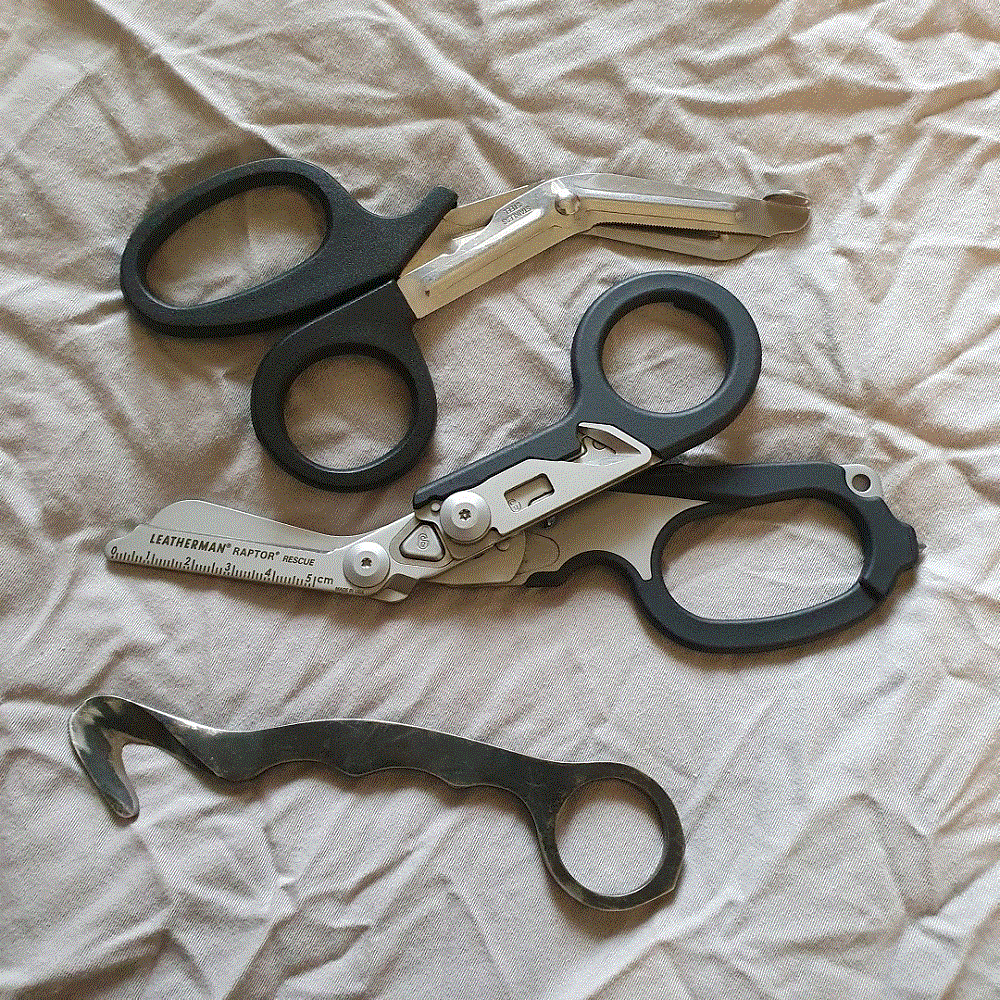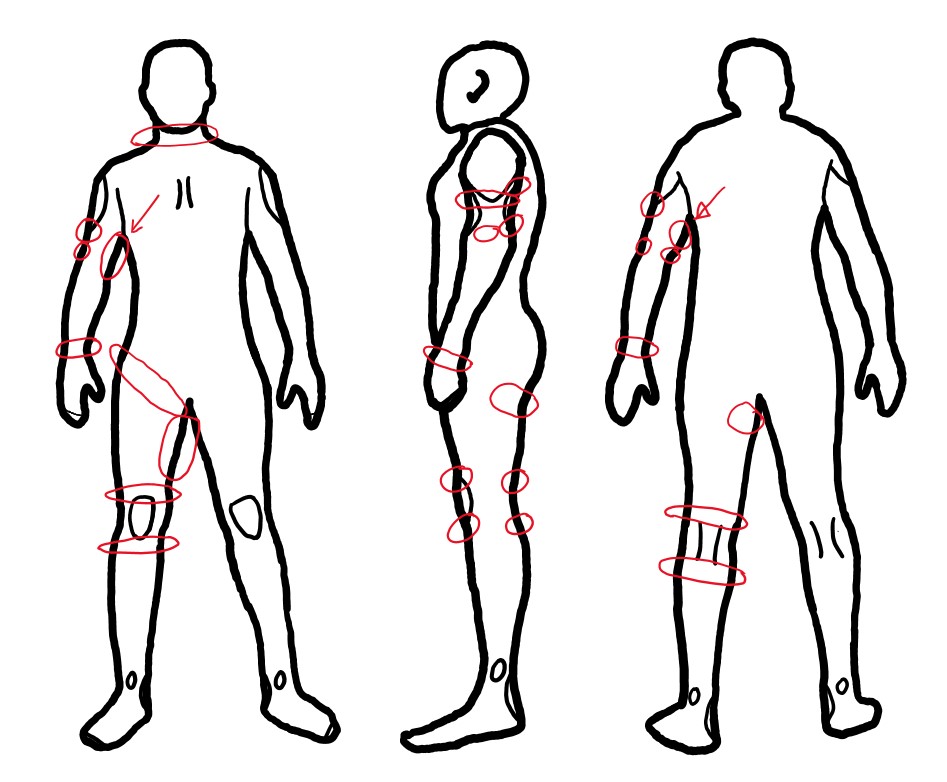Rope Safety
In this unit we will look at some safety points specific to rope play. Rope may seem safe as houses, but rope can be deceptively unforgiving when things go wrong.
In this unit we will look at some safety points specific to rope play. Rope may seem safe as houses, but rope can be deceptively unforgiving when things go wrong.
Contrary to what you might imagine, rope is one of the ‘big three’ kinks that cause more injuries to people in the kink world than any other.
It is a special combination of unintimidating (unlike things like impact), alluringly aesthetic (which bottoms often tend to appreciate), and a very common fantasy for many people. All these factors combined lead to the situation where lots of people want to try rope, sometimes without knowing everything they should before starting
Some good general advice:

1) Always have a safety cutter in reach, like a pair of EMT shears, or rescue hook. EMT shares can be purchased from places like The Saddlery Warehouse for (at the time of writing) $6, rescue hooks are more expensive, but are (usually) an all one piece, metal construction.
2) Do NOT use a knife as your safety cutter as you are likely to cut your partner.
3) A backup cutter in a slightly different location is a good idea in case you misplace the first one in a pile of clothes, bed sheets, or the primary one breaks.
4) When positioning the two safety cutters, position them so you can reach them regardless of where you and your partner are in the room; position them so you don’t have to fight a panicked rope bottom to get to the cutters.
5) It is a good idea to get some rope of similar size to what you will be tying with and cut it with your rescue cutter so you understand what it feels like to go through rope with your tool.
6) For a good read on safety in rope – https://crash-restraint.com/ties/1
Rope is a deceptively easy artform to walk away with an injury from. Most commonly this is a nerve compression injury. These can be a very subtle type of injury that creeps on slowly and unnoticed, there are many checks you can do as either a rope top, or a rope bottom.
Talking to your partner is incredibly important all throughout a rope scene. Ask them ‘how does that feel?’, ‘how do you feel?’, ‘any tingling?’/’any tingling in your fingers?’ are all good ideas as this will prompt your partner to think about not only how each tie feels, but if they like it, or what they like about it. try to avoid asking questions like “no tingling, right?” as this can promote a partner to answer with a “no, I feel fine” because the question is phrased in a way that makes them want to agree with it.

Physical checks you can do are placing your fingers in your partners hand and telling them to squeeze, you want to check for an imbalance in grip strength between their left and right, or any change from their normal grip strength.
Checks that bottoms can do include making the thumbs up, ok sign, and #2 fingers/bunny ears, and tapping each fingertip to the tip of the thumb. It’s also a great idea for rope bottoms to keep an eye on their own body; do YOU as the person being tied up feel any tingling? Feel any loss of sensation? Feel any loss of mobility or motor function?
Nerve safety is not just the responsibility of the top, they are not mind readers, know your body and report in when things are starting to feel unhappy (or let them know ahead of time you typically aren’t able to because you slip into ‘sub-space’). Remember; teamwork makes the dream work.
– https://crash-restraint.com/ties/1
– https://crash-restraint.com/ties/116
– https://ropestudy.com/courses/101/lessons/reducing-risk/topic/nerves/
– REEEEEAAALLY COOL diagrams – https://i0.wp.com/ropestudy.com/wp-content/uploads/2018/11/nerves-os-v4-1-1.jpg?ssl=1
Run your fingers down the sides of your opposite forearm. Just before the wrist, the bones of the forearm form a lump; on the other side of that lump is a groove, between where the bones of arm end and the bones of the hand begin. On both the thumb side and pinkie side of that groove, there are vulnerable sensory nerves. This is a common site for injury, because the groove is just the right width for a single piece of rope to become lodged in. Whenever tying the wrists, you want to ensure that the rope starts out above that groove on the forearm, and is loose enough that if it slides towards the hand, it will slide right past the groove and rest on the back of the hand.
This type of nerve injury on the thumb side is often referred to as Handcuff Neuropathy, after its most common cause.
Nerves in the extremities are most exposed to injury near the joints; for this reason you want to keep rope/pressure off the area right around the knees and elbows. Particular nerves of concern are the ulnar nerve, just above the elbow on the back of the arm (what you hit when you hit your funny bone), and the common peroneal nerve just below the knee on the outside of the leg. One of the most serious nerve injuries I’ve heard of was someone’s being left unable to walk normally for an extended period after hanging by rope behind their knees.
The single most common debilitating injury in the rope bondage community is radial nerve compression in the upper arm; this results in wrist drop, an inability to extend the hand at the wrist and to spread the fingers and thumb. Based on survey data, the radial nerve is potentially vulnerable along the back of the upper arm starting just below the deltoid muscle, all the way down to where the ulnar nerve becomes vulnerable above the elbow. While many people have some areas that can be tied safely on the upper arm, it is impossible to predict exactly where they will be, due to differences in individual anatomy.
Two sensory branches of the femoral nerve show patterns of being susceptible to bondage injury — the lateral femoral cutaneous, which can be pinched against the top of the front of the hips, and the anterior femoral cutaneous, which runs along the front of the thigh and appears most vulnerable right near the crease between thigh and abdomen. While these are usually injured only in suspension, I’ve also seen an extreme forward bend cause numbness in the upper thigh due to positional compression of a branch of the femoral nerve.
Pull laterally on the ankles so the legs are pulled out rather than down the line of the legs. If you want to pull the ankle down the line of the leg, use something like a gravity boot – https://www.theduchy.com/gravity-boot/
Nerves around the ankle are more resilient than the wrist, but still take care with the tendons and watch your partner closely. If they’re really pulling and fighting, consider changing the tie such that it applies pressure in a safer, better manner.
Be well hydrated and have eaten before your scene, just don’t go overboard and eat a large carb heavy meal.
Make sure you know what your partner needs for aftercare, and allow sufficient time in your session for as much aftercare as you and your partner need (don’t forget that tops ned aftercare too).
Rope connections blog has a great series on safety: https://www.ropeconnections.com/the-safety-series-part-1-physical-risk-with-rope-bondage/
Consider having a safety cheat sheet of things to ask your rope partner.